 San Francisco Chinatown, USA San Francisco Chinatown, USA
 San Francisco Chinatown is the largest and oldest Chinatown in North America. The 1850s saw its birth as an urban ghetto to which Chinese sojourners from Guanzhou were confined. In spite of great uncertainty in an America which passed a Chinese Exclusion Act in 1882, restricting emigration and denying Chinese but not offsping of theirs citizenship; it also reflected fear of Chinese intermarrying with the majority white population. Yet, in the face of crude xenophobia, the Chinese saw great opportunity in a country that they called 'Kin Shan'[Gold Mountain], for not only did they originally mine for gold before they were forced out of panning for this precious metal, but they scaled high mountains and laid rail from California for the continental railroad. San Francisco Chinatown is the largest and oldest Chinatown in North America. The 1850s saw its birth as an urban ghetto to which Chinese sojourners from Guanzhou were confined. In spite of great uncertainty in an America which passed a Chinese Exclusion Act in 1882, restricting emigration and denying Chinese but not offsping of theirs citizenship; it also reflected fear of Chinese intermarrying with the majority white population. Yet, in the face of crude xenophobia, the Chinese saw great opportunity in a country that they called 'Kin Shan'[Gold Mountain], for not only did they originally mine for gold before they were forced out of panning for this precious metal, but they scaled high mountains and laid rail from California for the continental railroad.
Today's San Francisco Chinatown has the shape of a trapezoid. It lies on the low end of Nob Hill, on one end, and on the other end, it hugs the downtown commercial and business district; it contains San Francisco's financial district and has partly absorbed North Beach, once home to Italians and then in the 1950s to the beatnicks. Its boundary horizontally fall within four streets: Kearny, Grant, Stockton, and Powell, and run vertically from Bush to the intersection of Powell and Columbus. Yet, its heartline goes from Sacromento to Jackson, although tourists can enter it through the dragon gate further down on Bush Street, or take the cable car on California. Its main street is Grant Avenue, which Chinatown alleys crisscross, and it is here are found Chinatown's businesses and banks and restaurants and tourist attraction.
San Francisco Chinatown is indeed a 'Gold Mountain' itself. It borders on the wealth of posh Nob Hill and the financial and commerical districts, but also its real estate is highly prized. San Francisco Chinatown houses a variety of institutions usually found in any Chinatown in the United States and Canada, with few exceptions, but its geographical setting enhance its charm and attraction.
To find the pulse of daily life of San Francisco, the wet markets on Sacromento. Here the hustle and bustle of food buying is heard with the colourful sounds of a chorus of Chinese dialects. Although non Chinese—tourist and San Francisco alike—may recognise many vegetables and meats and seafood, they will also find a menu of turtles or seiches or more exotic fruits and vegetables which grace Chinese tables. On other streets and alleys, the nose detects the aromas of herbs and the eye graces enless varieties of teas or hardwood household furnishings with among other items, furniture with mother of pearl inlaying or woks or cloth merchants with mannequins wearing the traditional Cheongsam which Wong Kai War's In the Mood for Love revived as a fashion or other Chinese dress. Of course, you name the regional Chinese cooking, and there's a restaurant to serve it up.
San Francisco Chinatown's Kong Chow Temple, founded in 1857, is a must stop for its green, red, and gold altars dedicated to Guan Gong. Then there is the oldest Buddhist Temple, the Norras Temple ; its altar is made of wood from China and the temple is decorated with small chariot markings of Tibetan Buddhism, and yet, it also house the Post Office. Then, we have the Tien Hau Temple (Mazu temple), designed in 1911, which overtime has taken on exotic form. Gaily painted on the outside, inside it exudes incense and here it bears opulence with pride and modern neon as a badge. On its top floor, as its name implies, it serves the Goddess of Heaven, Mazu. Let's not forget the Gold Mountlain Sagely Monastery devoted to the spread of Buddhism, contemplation, and chanting of sutras or the Chinese clan associations.
The oldest Catholic church Old St. Mary's Cathedral [California], originally built with granite from China, dates from 1854; the great San Francisco earthquake and fire destroyed it, but it was rebuilt in 1909. The oldest Protestant church is the First Chinese Baptist church [Waverly], organised in 1880, but rebuilt after the 1905 earthquake; today, it welcomes newer immigrations and offers them language classes.
And what about the Chinese Telephone Exchange, and not to be missed the Eastern Bakery for its mouth watering pasteries. No one should miss Porthsmouth Square near Kearney Street. There aunties and uncles practise Tai Chi, or pensioners play Chinese chess, or bring their canaries or crickets. For the sightseer who keeps a leisurely pace, there are bookshops, art galleries, tea houses, flower shops, or a quick look in the Chinese Historical Society of America, for example, to explore, or simply the pleasure of a moment of exotic frisson to silently walking through byways and long streets which take him out of the ordinary humdrum of daily American life. His ear picking up the tones of Cantonese or Mandarin or the blaring Chinese radio station. San Francisco Chinatown lives by night, too, wot, with its night clubs and bars and discos.
Yet, we would be remiss if we neglected the crowd pleasers which draw huge crowds to San Francisco Chinatown. Of course, the annual Chinese New Year Parade and the Chinese New Year Flower Fair. Traditional lion dances for the new year and for good luck for new businesses. The Chinese Culture Centre Spring Festival or the Chinatown Community Community Street Fair. And then there are the Spring and Autumn Moon Festivals, and the Miss Teen Chinatown pageant, and of course the Chinatown Night Market Fair.
With each event, the tourist finds a new face to San Francisco Chinatown, which remains the heart and soul of the city's Chinese community in spite of the increase of Chinese living in San Francisco and newer Chinatowns. Linked to San Francisco Chinatown's history is Angel Island which everyone should visit. Here Chinese emigrants were held and either allowed to enter California or were sent back for health and any other reason which sought to keep Chinese out of America, until repeal of the Chinese Exclusion Act during World War Two and the liberalisation of emigration restrictions in the 1960s. On this island in San Francisco Bay, you can see the cells in which Chinese and other Asians were held under quanrantine; on whose walls the plaintes and hopes of a new life were etched on stone walls in Chinese characters. And together with thriving Chinatowns and a growing population and the doggedness of ethnic group to stay in a country which at first rejected it, stands as a witness to the indomptable spirit of man.
Article contributed by Dr. Jak Cambria
Related article:
|
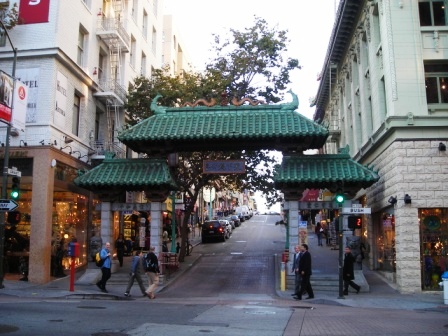
Archway of San Francisco Chinatown
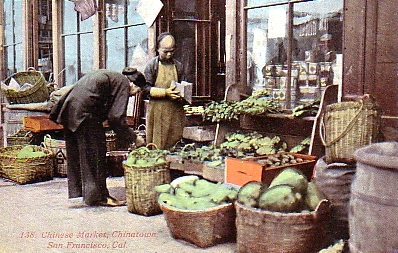
Chinese shop in San Francisco Chinatown circa 1920s

San Francisco Chinatown Grant Avenue circa 1915
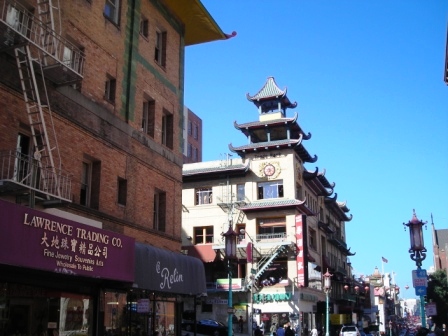
San Francisco Chinatown Grant Avenue 2008

Eastern Bakery, the oldest Chinese pastry shop in USA
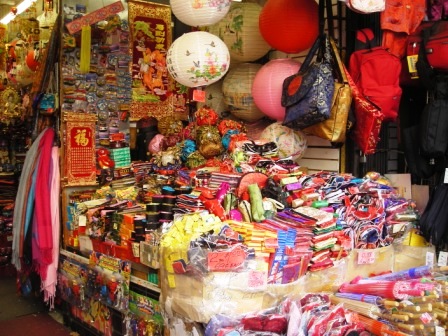
souvenir shop
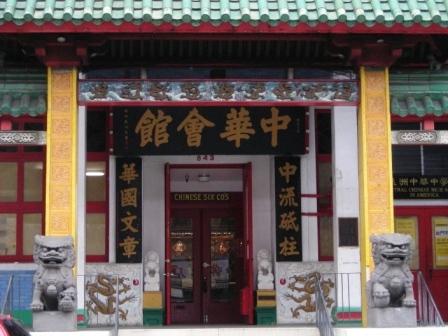
Chinese Consolidated Benevolent Association,
San Francisco, USA
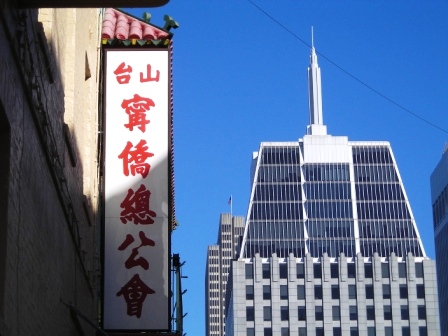
Chinese Clan Association
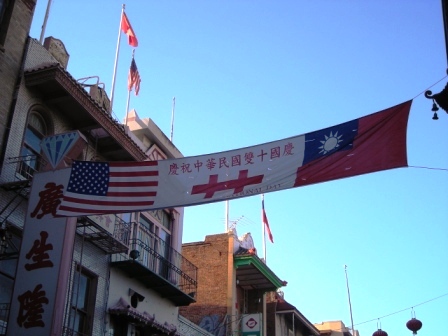
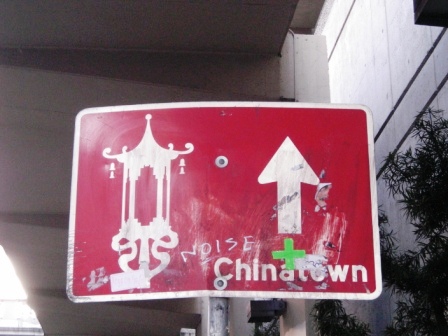
|

 San Francisco Chinatown, USA
San Francisco Chinatown, USA San Francisco Chinatown is the largest and oldest Chinatown in North America. The 1850s saw its birth as an urban ghetto to which Chinese sojourners from Guanzhou were confined. In spite of great uncertainty in an America which passed a Chinese Exclusion Act in 1882, restricting emigration and denying Chinese but not offsping of theirs citizenship; it also reflected fear of Chinese intermarrying with the majority white population. Yet, in the face of crude xenophobia, the Chinese saw great opportunity in a country that they called 'Kin Shan'[Gold Mountain], for not only did they originally mine for gold before they were forced out of panning for this precious metal, but they scaled high mountains and laid rail from California for the continental railroad.
San Francisco Chinatown is the largest and oldest Chinatown in North America. The 1850s saw its birth as an urban ghetto to which Chinese sojourners from Guanzhou were confined. In spite of great uncertainty in an America which passed a Chinese Exclusion Act in 1882, restricting emigration and denying Chinese but not offsping of theirs citizenship; it also reflected fear of Chinese intermarrying with the majority white population. Yet, in the face of crude xenophobia, the Chinese saw great opportunity in a country that they called 'Kin Shan'[Gold Mountain], for not only did they originally mine for gold before they were forced out of panning for this precious metal, but they scaled high mountains and laid rail from California for the continental railroad. 








